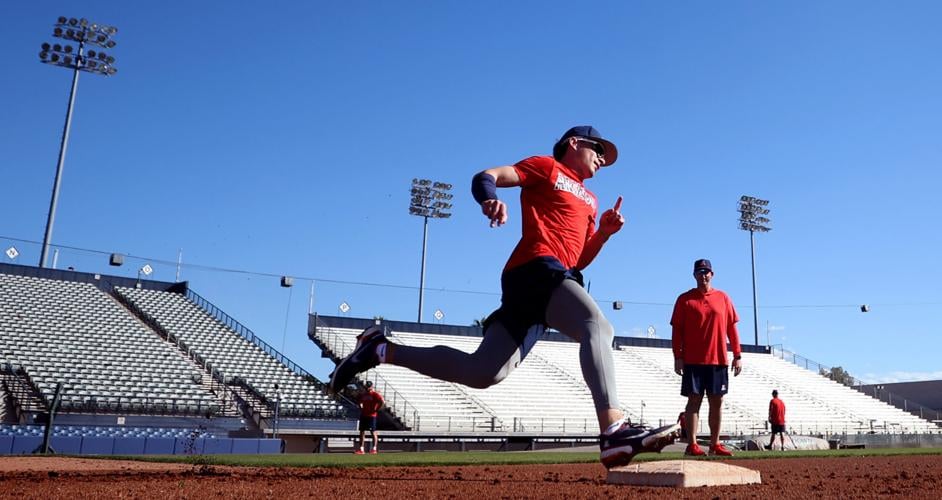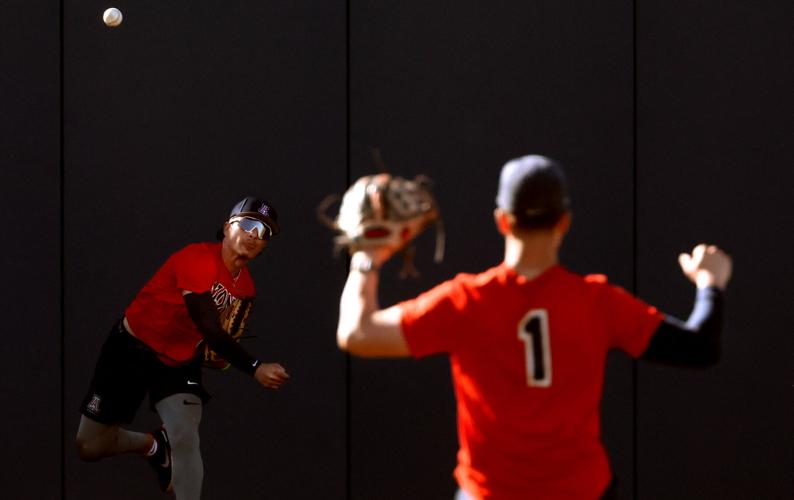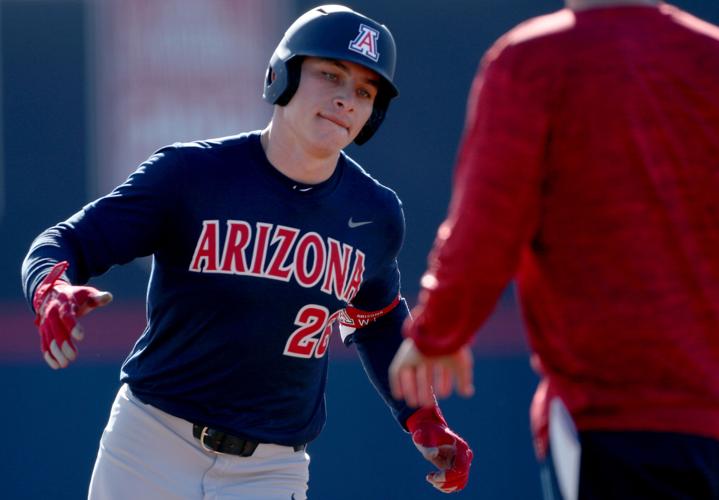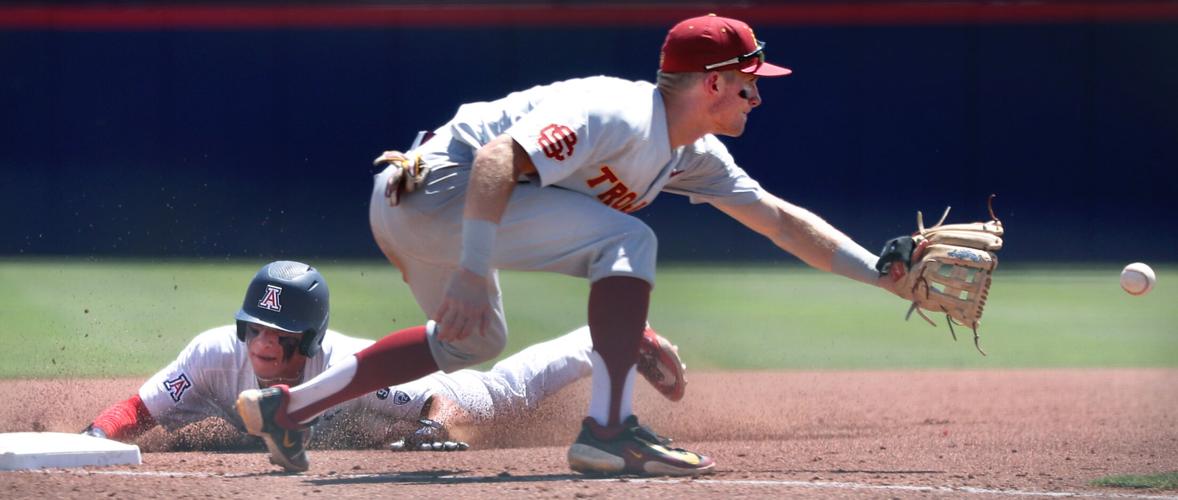His hitting coach swears it’s true. One of his teammates and best friends is also a believer.
Emilio Corona, they insist, possesses the “clutch gene.”
Is that really a thing? In an era of baseball in which everything can be quantified, do numbers exist to back up what Toby DeMello and Bradon Zastrow’s eyes and guts are telling them?
“As much as I love analytics,” said DeMello, Arizona’s hitting instructor, “it doesn’t tell you about the clutch gene.”

Emilio Corona rounds first on his way to second as the Wildcats work on base-running fundamentals during practice at Hi Corbett Field as Arizona baseball gets ready for the upcoming season.
But if you look hard enough, the proof can be found.
Let’s start with this: In 2023, Corona’s first season as a Wildcat, the then-junior went 6 for 14 (.429) with two home runs and 15 RBIs from the seventh inning on with runners in scoring position.
In all at-bats from the seventh inning on, Corona hit .383. (He wasn’t exactly a scrub in innings one through six: .314.)
Corona had two walk-off hits. He hit .351 against Pac-12 opponents. He batted .348 in six postseason games, second best on the team.

Right fielder Emilio Corona throws to cutoff man Garen Caulfield at second base during practice.
“I’d put him up there any day of the week to win a game,” said Zastrow, Corona’s teammate at Pima Community College and the UA the past two-plus seasons.
Derek Jeter is considered one of the greatest clutch baseball players of all time. The secret to his success: He was basically the same player in the postseason (.308 career batting average) as the regular season (.310).
Corona, Arizona’s starting right fielder after a stealthy, stellar ’23 campaign, defines his clutchness like this:
“I don’t make anything bigger than it is. I try and treat every at-bat (with) the same mentality. I don’t get scared by any bright lights or big moments.”
3-sport standout
Corona’s athletic background helps explain his makeup and mindset.
Corona played three sports at San Luis Obispo High School in California. In football, he was a quarterback — one who accounted for 52 touchdowns as a senior. In basketball, he was a point guard.

Arizona’s Emilio Corona celebrates his walk-off single that defeated Grand Canyon 10-9 in the 10th inning on March 28, 2023, at Hi Corbett Field.
Corona is accustomed to having the ball in his hands. He’s used to having pressure on his shoulders.
“You get a lot of experience trying to work through problems,” said Corona, who, along with his teammates, opens the ’24 season Friday vs. Northeastern.
Big moments, bright lights, hostile crowds — Corona embraces all of it. It should come as no surprise then that his most memorable performance as a Wildcat came on a relatively grand stage.
Aside from the ASU series in Phoenix, the largest road crowds Arizona played in front of last year were at Oregon State. The three-game series in Corvallis from April 28-30 averaged nearly 4,000 fans.
In Game 3, Corona slugged three home runs and totaled eight RBIs — feats that hadn’t been accomplished by a Wildcat in 15 and 21 years, respectively. The third homer, a three-run shot, came with two outs in the top of the ninth inning and gave Arizona a 10-8 lead.
“Never seen that in my life,” Zastrow said. “I played junior-college ball with the guy and seen him hit a boatload of homers. But for him to hit three in one game was just ... he just couldn’t miss.”

Emilio Corona rounds third after clouting a homer during the University of Arizona intra-squad scrimmage in 2023.
Corona said he was locked in that day and executed his plan. The atmosphere at Goss Stadium — one of the toughest road venues in the Pac-12 — actually helped.
“I’ve always liked crowds for some reason,” Corona said. “They had a great crowd that weekend, and it got a little chirpy. It kind of locked me in a little more.”
RBI machine
Arizona ended up losing that game and was only able to sneak into the NCAA Tournament thanks to a late-season surge and a run to the Pac-12 Tournament finals.
Corona established himself as a middle-of-the-lineup threat, batting .336 with 11 home runs and 44 RBIs in just 38 games. Three Wildcats had more RBIs than games played: Kiko Romero (school-record 89 in 59 games), Chase Davis (74 in 57) and Corona.
The RBI stat has been devalued as analytics have become more prevalent. There is a luck factor to it; if no one is on base, you can’t drive in a run unless you hit a home run.
UA coach Chip Hale has fully bought into baseball’s “new school” approach. But he still values a hitter who can produce with RISP. Corona is the epitome of clutch in that regard.
“People ... started to say, ‘Well, RBIs, it’s just because guys are on base for them.’ I have always said if you can find a guy that can drive people in, he’s a special person,” Hale said. “It’s not easy.”
Strike against him
Corona began his college career at Washington. He transferred after the 2021 season to Pima, a program some ex-teammates and coaches had recommended to him. In his lone season with the Aztecs, Corona hit .346 with 13 homers and 60 RBIs in 55 games.
“We got a good eye on him, and we knew he was a good power hitter,” Hale said. “We didn’t know until last year, when we were able to get him, how valuable he was going to be.”
Corona can make himself even more valuable — and raise his MLB Draft stock — by improving one particular aspect of his game.

Arizona’s Emilio Corona, left, beats the throw to USC third baseman Johnny Olmstead on a single to right by Mason White in the fourth inning of the first game of a Pac-12 doubleheader at Hi Corbett Field on May 19, 2023.
Among UA regulars, Corona had the highest strikeout rate (27.4%), the second-lowest walk rate (5.4%) and a team-worst 5.07 K/BB ratio. He chased balls out of the strike zone 30.5% of the time. Baseball America charted 56 hitters in its projected top 100 for the ’24 draft, and their average chase rate was 23.4%.
The tricky part when it comes to Corona: Arizona’s coaches don’t want to negate his power in the process.
“It’s a very fine line,” DeMello said. “I’m OK with guys’ strengths being their weakness. Emilio hit a lot of home runs and doubles on breaking balls last year. He’s able to do damage when they’re in the zone — but he chases them (out of the zone). So as much as I want to eliminate chase on those pitches, I also don’t want you to stop swinging at them in the zone because we are creating damage.”
Corona has done drills during the offseason to improve his pitch recognition. Sometimes, he’ll hit pitches off two machines stationed side by side, one throwing fastballs, the other breaking balls.
“He’s a worker,” DeMello said. “He wants to be really good.”
The work appears to be paying off. In the fall, Corona led the team in average exit velocity (97.9 mph), barrel rate (25%) and hard-hit rate (69%).
In those clutch situations last year — RISP from the seventh inning on — Corona rarely missed. He struck out only two times in 17 plate appearances, a rate of just 11.8%.
“Emilio has a really special way,” Hale said, “of being able to get big hits in big spots.”








